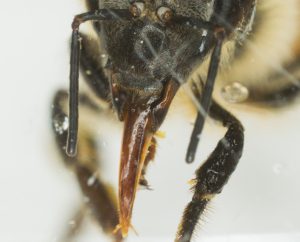Elephants, mosquitoes, and butterflies share something in common – they have a proboscis!
A proboscis is simply a long appendage coming out of an animal’s head, and is used to describe the nose or snout of a vertebrate, like an elephant, or the mouth of an insect, like a butterfly.
In insects, the proboscis is an elongated, tubular structure that is used for sucking food into the body. While butterflies and moths are perhaps best known for their proboscis, other insects like stink bugs, assassin bugs, and other pollinators like bees and flies also have one.
Pollinators use their proboscis to suck nectar from a flower. When the pollinator is feeding on nectar, the proboscis is extended from the body and reaches down into the flower to access the nectary at the base of the flower.

In some pollinators, like butterflies and moths, the proboscis is very long, many times the length of the insect’s entire body. However, in other pollinators like hoverflies, the proboscis is quite short and hardly noticeable. In bees, the proboscis length varies across species.
Honey bees and bumble bees are examples of bees with a longer proboscis, while sweat bees and mining bees have a shorter proboscis.
The length of the pollinator’s proboscis can determine which flowers it forages on. If the pollinator has a long proboscis, it can access nectar from long tubular or trumpet-shaped flowers. But pollinators with a short proboscis would have trouble getting that nectar without crawling into the flower, and so they tend to forage on flatter flowers like sunflowers or dandelions.
The shape of the flower and the length of the pollinator’s proboscis is a great example of coevolution, each structure changing over time in relation to the other due to their specialized relationship. Orchids are a diverse group that have very specialized relationships with pollinators.
Learn more here!
 0
0
